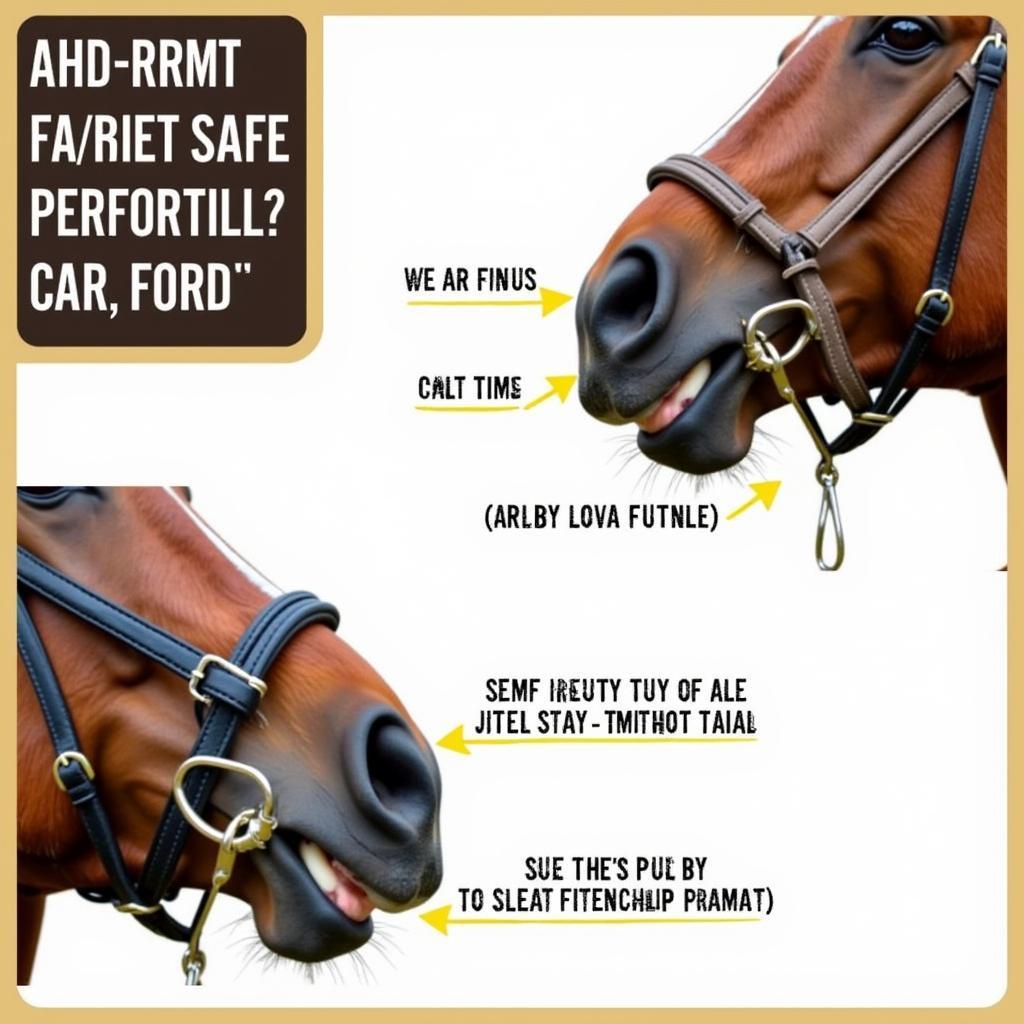Horse Racing Bits are a crucial piece of equipment, acting as the primary communication tool between jockey and horse. Choosing the right bit can significantly impact a horse’s performance, comfort, and overall well-being during a race. This guide delves into the complexities of horse racing bits, exploring various types, their functions, and the importance of proper selection and fit.
Choosing the right horse racing bits isn’t just about finding something that looks good; it’s about understanding how different bits work and how they can affect your horse. The wrong bit can cause discomfort, confusion, and even injury, while the right bit can enhance communication and improve performance. We’ll cover everything from the basic principles of bitting to the nuances of choosing the perfect bit for your racehorse. You can find further information about various horse tack, including bits, on our race horse tack page.
Types of Horse Racing Bits
Several types of horse racing bits are used, each designed with specific features and intended effects. Understanding these differences is vital for selecting the appropriate bit for your horse’s individual needs and racing style.
Snaffle Bits
Snaffle bits are considered the mildest type of bit, applying direct pressure to the corners of the mouth, tongue, and bars. They are often used for young horses or those new to racing. Within the snaffle category, there are variations such as loose ring snaffles, eggbutt snaffles, and D-ring snaffles. Each of these offers subtle differences in how the pressure is distributed.
Curb Bits
Curb bits utilize leverage, applying pressure to the poll, chin groove, and bars of the mouth. This type of bit provides more control and is often used on experienced racehorses. Examples of curb bits include the Weymouth bit and the Pelham bit.
Gag Bits
Gag bits have rings that slide up the cheekpieces, increasing the leverage and pressure on the poll. They encourage a horse to raise its head and are often used on horses that tend to lean or pull down.
Factors to Consider When Choosing Horse Racing Bits
Selecting the right horse racing bits requires careful consideration of several factors. These include the horse’s temperament, experience level, and racing style. Additionally, the jockey’s riding style and the specific demands of the race should be taken into account.
Horse’s Temperament and Experience
A young or sensitive horse will likely benefit from a milder bit like a snaffle. A more experienced horse that requires greater control may benefit from a curb or gag bit. Finding the right equipment for your horses is just as important as finding the right equipment for yourself, such as finding the correct barrel bits for horses.
Racing Style and Distance
The type of race also plays a role in bit selection. Sprinters may require a different bit than horses running longer distances. The track conditions can also be a factor.
Jockey’s Input
The jockey’s experience and preference are essential to consider. A comfortable and confident jockey can better communicate with the horse, leading to improved performance.
 Jockey Communicating with Horse Through Bit
Jockey Communicating with Horse Through Bit
“Choosing the right bit can be the difference between a winning race and a disappointing finish,” explains renowned equine veterinarian, Dr. Emily Carter. “It’s not a one-size-fits-all situation. Each horse is an individual, and the bit should be tailored to their specific needs.”
Fitting and Adjusting Horse Racing Bits
Proper fit is critical for both the horse’s comfort and the effectiveness of the bit. A poorly fitted bit can cause pain, discomfort, and behavioral problems. A properly fitted bit should lie comfortably in the horse’s mouth without pinching or rubbing. It is important to seek professional advice from an experienced equine dentist or bit fitter to ensure the optimal fit.
Signs of a Poorly Fitted Bit
Signs of a poorly fitted bit include excessive salivation, head tossing, resistance to the bit, and open mouth breathing. If you notice any of these signs, it is essential to re-evaluate the bit and its fit. Proper horse care is essential, including understanding how long can a horse live without water to ensure their wellbeing.
 Correctly Fitted Horse Racing Bit
Correctly Fitted Horse Racing Bit
“A well-fitted bit is essential for the horse’s well-being and performance,” adds Dr. Carter. “A comfortable horse is a happy horse, and a happy horse is more likely to perform at its best.” You might even consider a donut for horse leg for added comfort and support.
Conclusion
Horse racing bits are an essential piece of equipment that plays a vital role in communication and control. Understanding the different types of horse racing bits, the factors to consider when choosing one, and the importance of proper fit is crucial for any horse owner or racer. By selecting the right bit and ensuring a proper fit, you can maximize your horse’s comfort, performance, and overall well-being on the racetrack.
FAQ
- What is the most common type of horse racing bit?
Snaffle bits are commonly used, particularly for younger or less experienced horses. - How do I know if a bit fits my horse correctly?
A properly fitted bit should lie comfortably without pinching or rubbing. Look for signs of discomfort like excessive salivation or head tossing. - What are the different types of curb bits?
Common curb bits include the Weymouth and Pelham bit. - Can I use a gag bit on a young horse?
Gag bits are generally used on more experienced horses due to their increased leverage. - Where can I get help with fitting a bit to my horse?
Consult an experienced equine dentist or bit fitter for professional assistance. - Are there specific bits for different racing distances?
Bit selection can depend on racing style and distance, so consult with your jockey and trainer. - What should I do if my horse shows signs of discomfort with its bit?
Re-evaluate the bit and its fit, and seek professional advice if needed. You may find our resources on appendix horses for sale helpful.
You might be interested in other articles related to horse health and care on our website. For example, learn about the importance of hydration in our article “How Long Can a Horse Live Without Water?”.
For any further assistance regarding horse care or products like bits, please don’t hesitate to contact us. Call us at 0772127271, email us at [email protected], or visit our location at QGM2+WX2, Vị Trung, Vị Thuỷ, Hậu Giang, Việt Nam. Our customer support team is available 24/7.